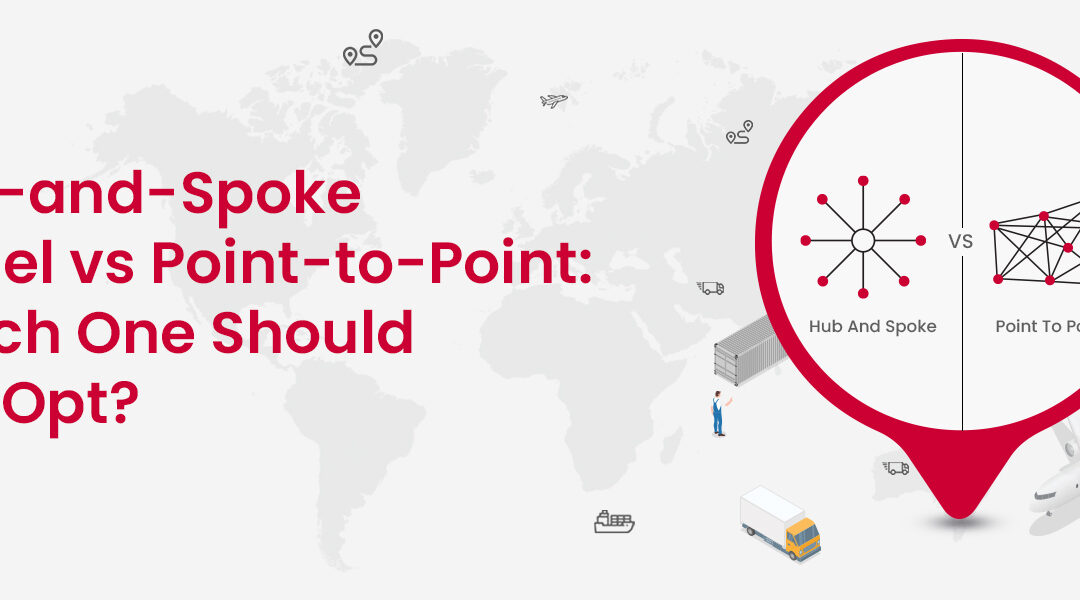There is a great deal of discussion on the appropriate overarching approach to use to assure the effectiveness of shipping services for eCommerce.
For example, the hub-and-spoke model technique and the point-to-point approach are two delivery methodologies of logistics solutions that are thought of as opposites on the connection spectrum, but which is the most effective plan for distribution via roads?
Understanding the distinctions between the point-to-point and hub-and-spoke models is helpful before delving further into the discussion.
A point-to-point system, or straightforward pickup and drop-off system, connects a group of places directly with all locations engaging with one another.
For instance, there would be 16 connections overall if eight places were to be connected directly, but on the other hand, only eight connections are needed when employing a hub-and-spoke arrangement.
The Point-to-Point Model
Let’s get into more detail about the point-to-point strategy in transportation planning. As previously indicated, this mode of transportation involves a vehicle moving straight from one place to another without stopping at any intermediate or temporary hub.
Even when the route may not be direct, it connects the group of places directly without pausing any services.
The Benefits of the Point-to-Point Model
Traveling Time is Faster
Point-to-point tactics have an advantage over others because they take much less time to travel. In addition, there is no need to stop or change directions because each location is immediately connected; instead,
it is a continuous, direct journey to the drop-off point.
This is achievable because each location has the tools and protocols to handle supplies from various sources separately.
Less Impactful Delays
Any delays in a point-to-point delivery would impact a single delivery. The concern with a hub-and-spoke system is that when a delay occurs, there could be a domino effect within the central hub, leading to a cascade of more delays.
The point-to-point approach can better accommodate and address any faults because it is more independent. As a result, this tactic is thought to be less prone to delays.
The Disadvantages of the Point-to-Point System
Expensive
Eight places were used as examples in the introduction, along with the connections needed for each methodology. More connections would be required for a point-to-point system, and enabling additional connections would result in a higher operational cost.
Not Effective
The point-to-point method in a roadway system necessitates using additional drivers to manage the multiple links.
Because so many drivers are moving in potentially comparable routes where loads can be shared, there is fear that their efforts are not being maximized. Unsurprisingly, the lack of efficiency ultimately results in higher expenses.
The Hub & Spoke Model
The hub-and-spoke strategy is at the other extreme of the spectrum. The hub-and-spoke model system connects several places within a network, known as the “spokes,” and consolidates the transportation assets through a central location, referred to as a “hub”.
As a result, a delivery would begin at one of the sites, travel to the hub, and then be either stored there or sent directly to another point within the network.
The principal benefit is that each entity only needs to establish and maintain a single technical link with a single entity—specifically, the federation’s central hub. The hub controls and directs connections between different entities.
Why is the hub-and-spoke model better than the point-to-point?
Only eight connections are needed when employing a hub-and-spoke arrangement. The hubs’ key benefits are economies of scale on connections by providing many services often.
For instance, four services per day could be possible between any two pairs in a point-to-point network instead of one service per day.
Hub-and-Spoke Model – A hub (central location) and spokes (various locations) are connected by a network using the hub-and-spoke model.
With international delivery, the hub-and-spoke arrangement is used 99% of the time.
Larger organizations build layers of hub-and-spoke networks that engage in global, national, and regional interaction. Transportation companies like DHL, UPS, FedEx, and NimbusPost, among others, are excellent examples of this strategy.
While it’s common to hear that larger aircraft and the hub-and-spoke business model (H&S) are no longer viable and that point-to-point (P2P) operations are the way of the future,
Emirates dares to keep adding jumbo aircraft to its fleet. The reason behind this is that the Emirates seems to be aware of something significant that is hidden from view by others.
Let’s examine the benefits of the hub-and-spoke design
Connections and economies of scale
A more effective connection system results in a higher frequency of services. For instance, four services per day could be possible between any two pairs in a point-to-point network instead of one service per day.
Economies of scale and hubs
Because there is more traffic at one location, efforts and resources can be concentrated on increasing distribution efficiency.
By merely sharing transportation resources, the upkeep of connections, the number of employees needed, and the number of cars required are all decreased.
The quality of a more focused infrastructure can then be improved with financial resources.
And lastly, what are the disadvantages of this methodology?
Service Point-to-Point Reduced
As the hub-and-spoke method centralizes power, some connections may experience delays and potential congestion because there isn’t a direct line connecting different points.
Not Flexible
Because everything is centralized and every connection inside the network is interconnected, there is a chance that something unpleasant will have a domino effect.
Because of this, delivery timings might occasionally be influenced by other deliveries. As a result, any issues will probably have a more significant impact than they would in a point-to-point system.
Final Thoughts
Just-in-time shipments make all the difference in the logistics industry. Yet the speed of shipments must be balanced with affordability.
To deliver products in the most cost-effective and timely way possible, forward-thinking logistics companies embrace hub-and-spoke models, where connections are arranged like a wheel.
Hub-and-spoke models are faster and more efficient and help companies keep a tighter grip on their delivery costs by passing down costs direct to the end consumer.
“New Problems need New Solutions”, and NimbusPost is always there for you in your eCommerce journey. By partnering with NimbusPost and leveraging our platform for all your operations regarding logistics and transportation, you can strategically steer a course toward efficiency.




